Overview
- Brief Narrative
- Pencil portrait by Fiszel Zber of a youthful fellow inmate with eyeglasses at Beaune-Le-Rolande internment camp in France where he was imprisoned from 1941-1942. Nazi Germany invaded France in May 1940. After the June armistice, the Germans occupied the north and western regions. In 1941, the Germans began rounding up Jewish residents who were not born in France. Zber, an artist specializing in woodcuts, was born in Poland. He was arrested as a foreign born Jew in 1941 and interned in Beaune-le-Rolande. While there, he drew scenes of the camp and the daily activities of the inmates. In 1942, the Germans began to deport foreign born Jews to concentration camps in the east. Zber was deported to Auschwitz where he was killed, age 33, on Oct. 26, 1942.
- Artwork Title
- Young Man with Spectacles, Beaune-la-Rolande, 1941
- Date
-
creation:
1941
depiction: 1941
- Geography
-
creation:
Beaune-la-Rolande (Concentration camp);
Beaune-la-Rolande (France)
depiction: Beaune-la-Rolande (Concentration camp); Beaune-la-Rolande (France)
- Credit Line
- United States Holocaust Memorial Museum Collection
- Signature
- front, bottom left corner, pencil : F. Zber / Au Camp [At the Camp] front, bottom left corner, pencil : F. Zber / Au Camp
- Contributor
-
Artist:
F. (Fiszl) Zber
Subject: F. (Fiszl) Zber
- Biography
-
Fiszel Zylberberg-Zber was a Jewish artist born in Plock, Poland, on June 23, 1909. By the 1930s, he was living in France and established as an artist, especially known for his woodcuts. In May 1940, Nazi Germany invaded France. An armistice was signed in June. Germany occupief the northern and western regions. In 1941, the German began arresting and interning foreign born Jews. Zber was detained around this time. He was sent to Beaune-la-Rolande internment camp. In 1942, the German began deporting the inmates to concentration camps in the east. Zber was deported on Convoy 6 to Auschwitz concentration camp in German occupied Poland where he was killed on October 26, 1942, at the age of 33.
Physical Details
- Language
- French
- Classification
-
Art
- Category
-
Drawings
- Object Type
-
Prisoners in art (lcsh)
- Physical Description
- Drawing in pencil on paper of a realistic portrait depicting the head and shoulders of a man in three quarter left profile wearing wire rim eyeglasses and a collared shirt. He has dark, disheveled hair, a faint mustache, and slightly parted, thick lips. The right side of his face is shaded. It is signed and dated at the bottom.
- Dimensions
- overall: Height: 8.250 inches (20.955 cm) | Width: 7.125 inches (18.098 cm)
- Materials
- overall : paper, graphite
Rights & Restrictions
- Conditions on Access
- No restrictions on access
- Conditions on Use
- No restrictions on use
Keywords & Subjects
- Topical Term
- Concentration camp inmates as artists--Beaune-la-Rolande--Biography. Concentration camps in art--France--Beaune-la-Rolande--Pictorial works. Deportees--France--Biography. Holocaust, Jewish (1939-1945)--France--Personal narratives. Holocaust, Jewish (1939-1945), in art--France. Jewish artists--France--Biography. World War, 1939-1945--Prisoners and prisons, German.
- Corporate Name
- Beaune-la-Rolande (Concentration camp)
Administrative Notes
- Legal Status
- Permanent Collection
- Provenance
- The drawing was acquired by the United States Holocaust Memorial Museum in 2003.
- Funding Note
- The cataloging of this artifact has been supported by a grant from the Conference on Jewish Material Claims Against Germany.
- Record last modified:
- 2023-07-24 13:16:08
- This page:
- https://collections.ushmm.org/search/catalog/irn522019
Download & Licensing
In-Person Research
- By Appointment
- Request 21 Days in Advance of Visit
- Plan a Research Visit
- Request to See This Object
Contact Us
Also in Internment camps of France in art collection
The collection consists of twenty drawings by Fiszel Zylberberg-Zber of an internment camp in Beaune-la-Rolande, France, two aquarelles by Jacques Gotko (Yankelli Gotkovski) of an internment camp in Compiègne, France, and a watercolor by an unknown artist of the transit camp in Drancy, France.
Date: 1941-1944
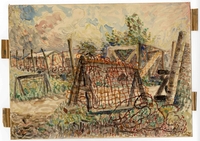
Aquarelle of a gated internment camp path by a Russian Jewish inmate
Object
Aquarelle created by Jacques Gotko in 1942 of a gate and barracks at Compiegne internment camp in France where he was a prisoner from July 1941- July 1943. Germany invaded France in May 1940. After the June armistice, the Germans occupied the north and western regions. In 1941, the Germans began rounding up Jewish residents who were not born in France. Gotko, a painter and native of Russia, was arrested in Paris as a foreign born Jew in July 1941 and interned in Compiegne. He drew scenes of the camp and the daily activities of the inmates. In 1942, the Germans began to systematically deport foreign born Jews to concentration camps in the east. Gotko was transferred to Drancy transit camp in Paris. On July 31, 1943, he was sent to Auschwitz where he died of typhus shortly after his arrival.
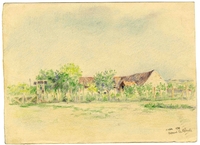
Colored drawing of internment camp barracks by a Polish Jewish inmate
Object
Colored pencil drawing by Fiszel Zber of the barracks at Beaune-Le-Rolande internment camp in France where he was imprisoned from 1941-1942. Nazi Germany invaded France in May 1940. After the June armistice, the Germans occupied the north and western regions. In 1941, the Germans began rounding up Jewish residents who were not born in France. Zber, an artist specializing in woodcuts, was born in Poland. He was arrested as a foreign born Jew in 1941 and interned in Beaune-le-Rolande. While there, he drew scenes of the camp and the daily activities of the inmates. In 1942, the Germans began to deport foreign born Jews to concentration camps in the east. Zber was deported to Auschwitz where he was killed, age 33, on Oct. 26, 1942.
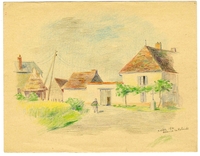
Drawing of a man walking in an internment camp by another inmate
Object
Colored pencil drawing by Fiszel Zber of a man walking past the barracks at Beaune-Le-Rolande internment camp in France where he was imprisoned from 1941-1942. Nazi Germany invaded France in May 1940. After the June armistice, the Germans occupied the north and western regions. In 1941, the Germans began rounding up Jewish residents who were not born in France. Zber, an artist specializing in woodcuts, was born in Poland. He was arrested as a foreign born Jew in 1941 and interned in Beaune-le-Rolande. While there, he drew scenes of the camp and the daily activities of the inmates. In 1942, the Germans began to deport foreign born Jews to concentration camps in the east. Zber was deported to Auschwitz where he was killed, age 33, on Oct. 26, 1942.

Color drawing of internment camp garden by a Polish Jewish inmate
Object
Colored pencil drawing by Fiszel Zber of the garden and a barrack at Beaune-Le-Rolande internment camp in France where he was imprisoned from 1941-1942. Nazi Germany invaded France in May 1940. After the June armistice, the Germans occupied the north and western regions. In 1941, the Germans began rounding up Jewish residents who were not born in France. Zber, an artist specializing in woodcuts, was born in Poland. He was arrested as a foreign born Jew in 1941 and interned in Beaune-le-Rolande. While there, he drew scenes of the camp and the daily activities of the inmates. In 1942, the Germans began to deport foreign born Jews to concentration camps in the east. Zber was deported to Auschwitz where he was killed, age 33, on Oct. 26, 1942.
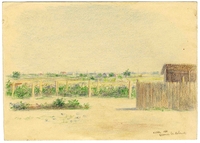
Color drawing of a fence near an internment camp garden by a Polish Jewish inmate
Object
Colored pencil drawing by Fiszel Zber of a large garden and a wooden fence at Beaune-Le-Rolande internment camp in France where he was imprisoned from 1941-1942. Nazi Germany invaded France in May 1940. After the June armistice, the Germans occupied the north and western regions. In 1941, the Germans began rounding up Jewish residents who were not born in France. Zber, an artist specializing in woodcuts, was born in Poland. He was arrested as a foreign born Jew in 1941 and interned in Beaune-le-Rolande. While there, he drew scenes of the camp and the daily activities of the inmates. In 1942, the Germans began to deport foreign born Jews to concentration camps in the east. Zber was deported to Auschwitz where he was killed, age 33, on Oct. 26, 1942.
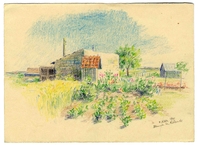
Color drawing of an internment camp flower garden by a Polish Jewish inmate
Object
Colored pencil drawing by Fiszel Zber of a garden with flowers near a shed at Beaune-Le-Rolande internment camp in France where he was imprisoned from 1941-1942. Nazi Germany invaded France in May 1940. After the June armistice, the Germans occupied the north and western regions. In 1941, the Germans began rounding up Jewish residents who were not born in France. Zber, an artist specializing in woodcuts, was born in Poland. He was arrested as a foreign born Jew in 1941 and interned in Beaune-le-Rolande. While there, he drew scenes of the camp and the daily activities of the inmates. In 1942, the Germans began to deport foreign born Jews to concentration camps in the east. Zber was deported to Auschwitz where he was killed, age 33, on Oct. 26, 1942.
Drawing of a tree at an internment camp by a Polish Jewish inmate
Object
Ink drawing by Fiszel Zber of a tree on the grounds of Beaune-Le-Rolande internment camp in France where he was imprisoned from 1941-1942. Nazi Germany invaded France in May 1940. After the June armistice, the Germans occupied the north and western regions. In 1941, the Germans began rounding up Jewish residents who were not born in France. Zber, an artist specializing in woodcuts, was born in Poland. He was arrested as a foreign born Jew in 1941 and interned in Beaune-le-Rolande. While there, he drew scenes of the camp and the daily activities of the inmates. In 1942, the Germans began to deport foreign born Jews to concentration camps in the east. Zber was deported to Auschwitz where he was killed, age 33, on Oct. 26, 1942.
Portrait of an old man in an internment camp hospice by a Polish Jewish inmate
Object
Ink portrait by Fiszel Zber of an old man in the hospice at Beaune-Le-Rolande internment camp in France where he was imprisoned from 1941-1942. Nazi Germany invaded France in May 1940. After the June armistice, the Germans occupied the north and western regions. In 1941, the Germans began rounding up Jewish residents who were not born in France. Zber, an artist specializing in woodcuts, was born in Poland. He was arrested as a foreign born Jew in 1941 and interned in Beaune-le-Rolande. While there, he drew scenes of the camp and the daily activities of the inmates. In 1942, the Germans began to deport foreign born Jews to concentration camps in the east. Zber was deported to Auschwitz where he was killed, age 33, on Oct. 26, 1942.
Sketch of fields near an internment camp by a Polish Jewish inmate
Object
Ink sketch by Fiszel Zber of the fields surrounding Beaune-Le-Rolande internment camp in France where he was imprisoned from 1941-1942. Nazi Germany invaded France in May 1940. After the June armistice, the Germans occupied the north and western regions. In 1941, the Germans began rounding up Jewish residents who were not born in France. Zber, an artist specializing in woodcuts, was born in Poland. He was arrested as a foreign born Jew in 1941 and interned in Beaune-le-Rolande. While there, he drew scenes of the camp and the daily activities of the inmates. In 1942, the Germans began to deport foreign born Jews to concentration camps in the east. Zber was deported to Auschwitz where he was killed, age 33, on Oct. 26, 1942.
Sketch of a field on the edge of town by a Polish Jewish internment inmate
Object
Ink sketch by Fiszel Zber of a field at the end of the town near Beaune-Le-Rolande internment camp in France where he was imprisoned from 1941-1942. Nazi Germany invaded France in May 1940. After the June armistice, the Germans occupied the north and western regions. In 1941, the Germans began rounding up Jewish residents who were not born in France. Zber, an artist specializing in woodcuts, was born in Poland. He was arrested as a foreign born Jew in 1941 and interned in Beaune-le-Rolande. While there, he drew scenes of the camp and the daily activities of the inmates. In 1942, the Germans began to deport foreign born Jews to concentration camps in the east. Zber was deported to Auschwitz where he was killed, age 33, on Oct. 26, 1942.
Drawings of internment camp inmates by a Polish Jewish inmate
Object
Pencil drawing by Fiszel Zber of side by side drawings of camp inmates at rest at Beaune-Le-Rolande internment camp in France where he was imprisoned from 1941-1942. Nazi Germany invaded France in May 1940. After the June armistice, the Germans occupied the north and western regions. In 1941, the Germans began rounding up Jewish residents who were not born in France. Zber, an artist specializing in woodcuts, was born in Poland. He was arrested as a foreign born Jew in 1941 and interned in Beaune-le-Rolande. While there, he drew scenes of the camp and the daily activities of the inmates. In 1942, the Germans began to deport foreign born Jews to concentration camps in the east. Zber was deported to Auschwitz where he was killed, age 33, on Oct. 26, 1942.
Sketches of internment camp inmates by a Polish Jewish inmate
Object
Pencil studies of fellow inmates at rest drawn by Fiszel Zber at Beaune-Le-Rolande internment camp in France where he was imprisoned from 1941-1942. Nazi Germany invaded France in May 1940. After the June armistice, the Germans occupied the north and western regions. In 1941, the Germans began rounding up Jewish residents who were not born in France. Zber, an artist specializing in woodcuts, was born in Poland. He was arrested as a foreign born Jew in 1941 and interned in Beaune-le-Rolande. While there, he drew scenes of the camp and the daily activities of the inmates. In 1942, the Germans began to deport foreign born Jews to concentration camps in the east. Zber was deported to Auschwitz where he was killed, age 33, on Oct. 26, 1942.
Studies of internment camp inmates by a Polish Jewish inmate
Object
Five studies of inmates in various positions drawn by Fiszel Zber at Beaune-Le-Rolande internment camp in France where he was imprisoned from 1941-1942. Nazi Germany invaded France in May 1940. After the June armistice, the Germans occupied the north and western regions. In 1941, the Germans began rounding up Jewish residents who were not born in France. Zber, an artist specializing in woodcuts, was born in Poland. He was arrested as a foreign born Jew in 1941 and interned in Beaune-le-Rolande. While there, he drew scenes of the camp and the daily activities of the inmates. In 1942, the Germans began to deport foreign born Jews to concentration camps in the east. Zber was deported to Auschwitz where he was killed, age 33, on Oct. 26, 1942.
Double drawing of people waiting at a station by a Polish Jewish inmate
Object
Side by side drawings of a rail station with people waiting drawn by Fiszel Zber at Beaune-Le-Rolande internment camp in France where he was imprisoned from 1941-1942. Nazi Germany invaded France in May 1940. After the June armistice, the Germans occupied the north and western regions. In 1941, the Germans began rounding up Jewish residents who were not born in France. Zber, an artist specializing in woodcuts, was born in Poland. He was arrested as a foreign born Jew in 1941 and interned in Beaune-le-Rolande. While there, he drew scenes of the camp and the daily activities of the inmates. In 1942, the Germans began to deport foreign born Jews to concentration camps in the east. Zber was deported to Auschwitz where he was killed, age 33, on Oct. 26, 1942.
Portrait of an internment camp inmate by a Polish Jewish inmate
Object
Pencil portrait with studies drawn by Fiszel Zber at Beaune-Le-Rolande internment camp in France where he was imprisoned from 1941-1942. Nazi Germany invaded France in May 1940. After the June armistice, the Germans occupied the north and western regions. In 1941, the Germans began rounding up Jewish residents who were not born in France. Zber, an artist specializing in woodcuts, was born in Poland. He was arrested as a foreign born Jew in 1941 and interned in Beaune-le-Rolande. While there, he drew scenes of the camp and the daily activities of the inmates. In 1942, the Germans began to deport foreign born Jews to concentration camps in the east. Zber was deported to Auschwitz where he was killed, age 33, on Oct. 26, 1942.
Double sided drawing of three camp inmates by a Polish Jewish inmate
Object
Two sided drawing of 3 seated men, a field, and a town drawn by Fiszel Zber at Beaune-Le-Rolande internment camp in France where he was imprisoned from 1941-1942. Nazi Germany invaded France in May 1940. After the June armistice, the Germans occupied the north and western regions. In 1941, the Germans began rounding up Jewish residents who were not born in France. Zber, an artist specializing in woodcuts, was born in Poland. He was arrested as a foreign born Jew in 1941 and interned in Beaune-le-Rolande. While there, he drew scenes of the camp and the daily activities of the inmates. In 1942, the Germans began to deport foreign born Jews to concentration camps in the east. Zber was deported to Auschwitz where he was killed, age 33, on Oct. 26, 1942.
Sketches of inamtes during free time by a Polish Jewish inmate
Object
Two sided drawing of 3 seated men, a field, and a town drawn by Fiszel Zber at Beaune-Le-Rolande internment camp in France where he was imprisoned from 1941-1942. Nazi Germany invaded France in May 1940. After the June armistice, the Germans occupied the north and western regions. In 1941, the Germans began rounding up Jewish residents who were not born in France. Zber, an artist specializing in woodcuts, was born in Poland. He was arrested as a foreign born Jew in 1941 and interned in Beaune-le-Rolande. While there, he drew scenes of the camp and the daily activities of the inmates. In 1942, the Germans began to deport foreign born Jews to concentration camps in the east. Zber was deported to Auschwitz where he was killed, age 33, on Oct. 26, 1942.
Studies of camp inmates by a Polish Jewish inmate
Object
Studies of men in repose drawn by Fiszel Zber at Beaune-Le-Rolande internment camp in France where he was imprisoned from 1941-1942. Nazi Germany invaded France in May 1940. After the June armistice, the Germans occupied the north and western regions. In 1941, the Germans began rounding up Jewish residents who were not born in France. Zber, an artist specializing in woodcuts, was born in Poland. He was arrested as a foreign born Jew in 1941 and interned in Beaune-le-Rolande. While there, he drew scenes of the camp and the daily activities of the inmates. In 1942, the Germans began to deport foreign born Jews to concentration camps in the east. Zber was deported to Auschwitz where he was killed, age 33, on Oct. 26, 1942.
Drawing of camp inmates writing by a Polish Jewish inmate
Object
Studies of camp inmates writing drawn by Fiszel Zber at Beaune-Le-Rolande internment camp in France where he was imprisoned from 1941-1942. Nazi Germany invaded France in May 1940. After the June armistice, the Germans occupied the north and western regions. In 1941, the Germans began rounding up Jewish residents who were not born in France. Zber, an artist specializing in woodcuts, was born in Poland. He was arrested as a foreign born Jew in 1941 and interned in Beaune-le-Rolande. While there, he drew scenes of the camp and the daily activities of the inmates. In 1942, the Germans began to deport foreign born Jews to concentration camps in the east. Zber was deported to Auschwitz where he was killed, age 33, on Oct. 26, 1942.
Studies of camp inmates reading by a Polish Jewish inmate
Object
Sketches of inmates reading drawn by Fiszel Zber at Beaune-Le-Rolande internment camp in France where he was imprisoned from 1941-1942. Nazi Germany invaded France in May 1940. After the June armistice, the Germans occupied the north and western regions. In 1941, the Germans began rounding up Jewish residents who were not born in France. Zber, an artist specializing in woodcuts, was born in Poland. He was arrested as a foreign born Jew in 1941 and interned in Beaune-le-Rolande. While there, he drew scenes of the camp and the daily activities of the inmates. In 1942, the Germans began to deport foreign born Jews to concentration camps in the east. Zber was deported to Auschwitz where he was killed, age 33, on Oct. 26, 1942.



